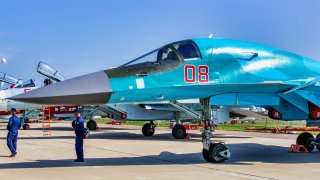Russia's Mighty Su-34 Fullback Fighter-Bomber Faces Nightmare Scenario
In February, Ukrainian forces dramatically impacted Russian aerial operations over Ukraine, claiming to have downed 13 Russian aircraft, including ten Su-34 fighter bombers, in just 13 days.
Summary: In February, Ukrainian forces dramatically impacted Russian aerial operations over Ukraine, claiming to have downed 13 Russian aircraft, including ten Su-34 fighter bombers, in just 13 days. These losses highlight the unsustainable attrition rate of Russia's aircraft, particularly the Su-34s, crucial for Moscow's winter offensive. The heavy losses force Russia to consider measures to compensate, such as eliminating Ukrainian anti-air capabilities or accelerating Su-34 production. However, challenges such as maintenance backlogs and pilot shortages complicate these responses. The situation underscores the significant strain on Russia's military resources and the increasing difficulties faced by its air force in the ongoing conflict.
Russia's Aerial Dilemma: Sustaining the Su-34 Fleet Amidst Ukrainian Pressure
Russian aircraft, especially Sukhoi Su-34 fighter-bombers, have been struggling to survive in the contested airspace over Ukraine.
In the month of February, Ukrainian anti-air crews claim to have shot down 13 Russian aircraft in just 13 days.
“It seems like being a Russian military plane pilot is the worst job in the world,” Ukraine’s Defense Ministry posted to X. “February is the shortest month of the year, but our sky defenders have achieved the greatest results in downing Russian jets since October 2022.”
According to Kyiv, the kill count included ten Su-34 fighter bombers (plus two Su-35 fighters and one A-50 long-range radar detection and control aircraft).
Assuming that Kyiv’s tally is truthful, then Russian’s aircraft attrition rate is likely unsustainable.
What can Putin’s beleaguered forces do to compensate for, or avoid, such heavy losses?
The Su-34 over Ukraine
“Russia’s Su-34s have been playing a key role in supporting Moscow’s winter offensive on the eastern front,” Newsweek reported. “Air dropped KAB glide bombs have been credited as vital to Russian success in and around the small city Avdiivka, with Ukrainian defenders lacking the air-defense capabilities to stop such sorties. Russian fighter-bombers can release the munitions from as far as 25 miles away.”
So, the Su-34 is vital to Russians efforts – meaning the loss of so many Su-34s is devastating to Russian efforts. Accordingly, adjustments must be made to massive losses. Specifically, Russia needs to eliminate the systems that are causing the aircraft hemorrhage, like Ukrainian radar and surface-to-air missiles. Easier said than done – especially considering that the tools to identify and eliminate said systems are the tools being shot down, i.e., the Su-34 and the A-50, etc. So, Russia may have a little bit of a pickle.
Another option, potentially, would be to accelerate the production and delivery of the Su-34s.
Again, easier said than done. “Russia’s air force has acquired a total of 140 Su-34 fighter-bombers,” Newsweek reported. And “as of Friday, Ukraine claims to have downed 35 of them,” while Oryx open-source intelligence tracker lists 25 Su-34s destroyed.
Either way, Russia has about one hundred or so Su-34s remaining. But the one hundred or no number may be misleading, as a significant portion of the aircraft may be out of service. The Russians may well have a backlog of maintenance issues.
Or perhaps there is a shortage of pilots or a bottleneck at flight school. Just because Russia has the jets on the tarmac doesn’t mean they are ready to fly. Flying the jets increases the likelihood that they, too, will be shot down, which further exacerbates the problem and increases pressure upon a Russian military-industrial complex that is already overtaxed.
“The impact of losing 13 aircraft in almost as many days, and possibly some their highly trained pilots, is not negligible for the Russian military,” the Institute for the Study of War wrote.
“Overuse of these aircraft is also costing Russia as the war drags on,” said Michael Bohnert, an engineer at RAND Corporation. “In a protracted war, where one force tries to exhaust the other, it’s the total longevity of the military force that matters. And that’s where the [Russian air force] finds itself now.”
Moreover, whereas the Ukrainian air force has reinforcements from Western allies, the Russians are likely to be on their own when it comes to replenishing their stock of depleted fighter-bombers.
About the Author: Harrison Kass
Harrison Kass is a defense and national security writer with over 1,000 total pieces on issues involving global affairs. An attorney, pilot, guitarist, and minor pro hockey player, Harrison joined the US Air Force as a Pilot Trainee but was medically discharged. Harrison holds a BA from Lake Forest College, a JD from the University of Oregon, and an MA from New York University. Harrison listens to Dokken.


